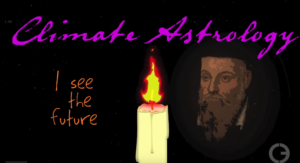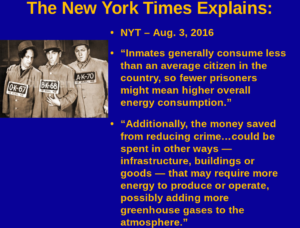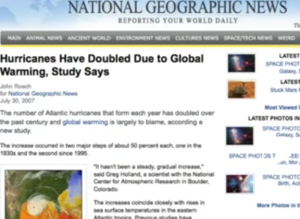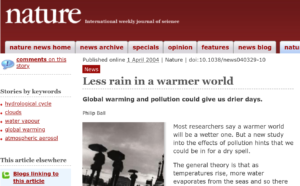Science is Falsifiable – Clear Energy Alliance
In order to know if a theory could be true, there must be a way to prove it to be false. Unfortunately, many climate change scientists, the media and activists are ignoring this cornerstone of science. In this bizarre new world, all unwelcome climate events are caused by climate change. But as legendary scientific philosopher Karl Popper noted, “A theory that explains everything, explains nothing.”
Marc Morano explains.
Transcript:
Morano: Did you know man-caused climate change is resulting in LESS snowfall…but also MORE snowfall? Or that it leads to drought, EXCEPT when it leads to flooding? Or that it causes MORE hurricanes — or FEWER hurricanes. Or that it causes our days to get longer… but ONLY when it’s not causing them to get shorter? Are you confused? Who wouldn’t be?
This is where the scientific principle that requires theories to be “falsifiable” should come into play. Simply put, there must be a way to prove a theory false in order to know if it could be true. This idea was proposed by Karl Popper in the mid 20th century and it has been a central tenet for all scientific inquiry ever since.
For example, horoscopes are not scientific because there is no way to disprove claims that are broad, vague and contradictory. How could you disprove a horoscope that says, “Now is a good time to be starting something new,” or “The universe is pushing you into a more polarized environment”?
Conversely, Sir Isaac Newton’s theories ARE falsifiable. Because we can test the idea that for every action there is an equal and opposite reaction, we know that the principle is true.
Now consider some of the claims being made by climate change activists. We’ve been told climate change leads to less snow AND that it leads to more snow. It makes wet places wetter and dry places dryer… EXCEPT when it is making wet places dryer AND dry places wetter. It causes more hurricanes and fewer hurricanes, longer bird migrations and also shorter bird migrations. Global warming causes more crime, but, get this, reducing crime causes more global warming. And if you disagree with any part of this of scenario…you might just be a “climate denier”— and belong in jail yourself!
And that’s only a small sampling of all the things attributed to climate change… the opposite of which are ALSO attributed to climate change.
Karl Popper would call BS on all of this. If any and all climate conditions are being attributed to climate change, then how can we design any observation or experiment that would make climate change falsifiable? We can’t. If it’s not falsifiable, it’s not science.
Today…A sort of “climate astrology” has taken over. Many climate claims have descended into the realm of the predictions of Nostradamus or the Mayan calendar. There is no way anyone can falsify the global warming theory now because any weather event that happens “proves” their case.
And if that isn’t confusing enough already, how do we design an experiment to know what changes in the climate are due to human activities or are part of the natural order of things. In other words, is there any experiment or observation that can distinguish what is man-caused climate change and what is simply just… natural climate? There isn’t one today and there may never be one.
If scientists want the public to take the theory of man-caused climate change seriously, they need to become a lot more disciplined. Claiming that human-induced climate change is responsible for just about every typical AND atypical climate event doesn’t pass the sniff test. Essentially, climate activists have announced that many “bad things” will happen because of man-made global warming — and lo and behold, every time something bad happens, they say ‘See we told you so!’ As Karl Popper would say, A theory that explains everything, doesn’t really explain anything.
For the Clear Energy Alliance, I’m Marc Morano. Power On.
Sources:
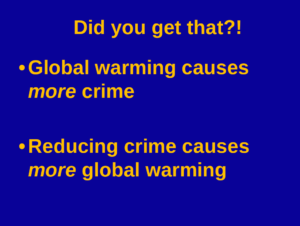
More lightning, less lightning…

Except when it causes more lightning strikes
Study: ‘The US Will See 50‰ More Lightning Strikes, Thanks to Global Warming’
And more deaths…

Flashback 2007: ‘Global warming’ will ‘reduce the length of a day’ – ‘Make Earth spin faster’

(More: via the Corbett Report)
Climate change makes for shorter winters
Climate change makes for harsher winters
Climate change means less snow

Climate change means more snow
Climate change causes droughts in California
Climate change causes floods in Texas and Oklahoma
Climate change makes wet places wetter and dry places drier…

…except when it makes wet places dryer…

…and dry places wetter

Climate change causes more hurricanes
Climate change causes less hurricanes
Climate change causes more rain (but less water)
Climate change causes less rain
Climate change decreases the spread of malaria
Climate change increases the spread of malaria
Climate change makes San Francisco foggier
Climate change makes San Francisco less foggy
Climate change causes duller autumn leaves
Climate changes causes more colorful autumn leaves
Climate change makes for less salty seas
Climate change makes for saltier seas
Climate change causes Antarctica to lose land ice

Climate change causes Antarctica to gain land ice?
Climate change makes the earth hotter…

…in which case climate change can explain that, too.

Science as Falsification
The following excerpt was originally published in Conjectures and Refutations (1963).
by Karl R. Popper
![]()
![]()
hen I received the list of participants in this course and realized that I had been asked to speak to philosophical colleagues I thought, after some hesitation and consolation, that you would probably prefer me to speak about those problems which interests me most, and about those developments with which I am most intimately acquainted. I therefore decided to do what I have never done before: to give you a report on my own work in the philosophy of science, since the autumn 1919 when I first begin to grapple with the problem, “When should a theory be ranked as scientific?” or “Is there a criterion for the scientific character or status of a theory?“
The problem which troubled me at the time was neither, “When is a theory true?” nor “When is a theory acceptable?” my problem was different. I wished to distinguish between science and pseudo–science; knowing very well that science often errs, and that pseudoscience may happen to stumble on the truth.
I knew, of course, the most widely accepted answer to my problem: that science is distinguished from pseudoscience—or from “metaphysics”—by its empirical method, which is essentially inductive, proceeding from observation or experiment. But this did not satisfy me. On the contrary, I often formulated my problem as one of distinguishing between a genuinely empirical method and a non-empirical or even pseudo-empirical method — that is to say, a method which, although it appeals to observation and experiment, nevertheless does not come up to scientific standards. The latter method may be exemplified by astrology, with its stupendous mass of empirical evidence based on observation — on horoscopes and on biographies.
But as it was not the example of astrology which lead me to my problem, I should perhaps briefly describe the atmosphere in which my problem arose and the examples by which it was stimulated. After the collapse of the Austrian empire there had been a revolution in Austria: the air was full of revolutionary slogans and ideas, and new and often wild theories. Among the theories which interested me Einstein’s theory of relativity was no doubt by far the most important. The three others were Marx’s theory of history, Freud’s psycho-analysis, and Alfred Adler’s so-called “individual psychology.”
There was a lot of popular nonsense talked about these theories, and especially about relativity (as still happens even today), but I was fortunate in those who introduced me to the study of this theory. We all—the small circle of students to which I belong—were thrilled with the result of Eddington’s eclipse observations which in 1919 brought the first important confirmation of Einstein’s theory of gravitation. It was a great experience for us, and one which had a lasting influence on my intellectual development.
The three other theories I have mentioned were also widely discussed among students at the time. I myself happened to come into personal contact with Alfred Adler, and even to cooperate with him in his social work among the children and young people in the working-class districts of Vienna where he had established social guidance clinics.
It was the summer of 1919 that I began to feel more and more dissatisfied with these three theories—the Marxist theory of history, psycho-analysis, and individual psychology; and I began to feel dubious about their claims to scientific status. My problem perhaps first took the simple form, “What is wrong with Marxism, psycho-analysis, and individual psychology? Why are they so different from physical theories, from Newton’s theory, and especially from the theory of relativity?”
To make this contrast clear I should explain that few of us at the time would have said that we believed in the truth of Einstein’s theory of gravitation. This shows that it was not my doubting the truth of those three other theories which bothered me, but something else. Yet neither was it that I nearly felt mathematical physics to be more exact than sociological or psychological type of theory. Thus what worried me was neither the problem of truth, at that stage at least, nor the problem of exactness or measurability. It was rather that I felt that these other three theories, though posing as science, had in fact more in common with primitive myths than with science; that they resembled astrology rather than astronomy.
I found that those of my friends who were admirers of Marx, Freud, and Adler, were impressed by a number of points common to these theories, and especially by their apparent explanatory power. These theories appear to be able to explain practically everything that happened within the fields to which they referred. The study of any of them seemed to have the effect of an intellectual conversion or revelation, open your eyes to a new truth hidden from those not yet initiated. Once your eyes were thus opened you saw confirmed instances everywhere: the world was full of verifications of the theory. Whatever happened always confirmed it. Thus its truth appeared manifest; and unbelievers were clearly people who did not want to see the manifest truth; who refuse to see it, either because it was against their class interest, or because of their repressions which were still “un-analyzed” and crying aloud for treatment.
The most characteristic element in this situation seemed to me the incessant stream of confirmations, of observations which “verified” the theories in question; and this point was constantly emphasize by their adherents. A Marxist could not open a newspaper without finding on every page confirming evidence for his interpretation of history; not only in the news, but also in its presentation — which revealed the class bias of the paper — and especially of course what the paper did not say. The Freudian analysts emphasized that their theories were constantly verified by their “clinical observations.” As for Adler, I was much impressed by a personal experience. Once, in 1919, I reported to him a case which to me did not seem particularly Adlerian, but which he found no difficulty in analyzing in terms of his theory of inferiority feelings, Although he had not even seen the child. Slightly shocked, I asked him how he could be so sure. “Because of my thousandfold experience,” he replied; whereupon I could not help saying: “And with this new case, I suppose, your experience has become thousand-and-one-fold.”
What I had in mind was that his previous observations may not have been much sounder than this new one; that each in its turn had been interpreted in the light of “previous experience,” and at the same time counted as additional confirmation. What, I asked myself, did it confirm? No more than that a case could be interpreted in the light of a theory. But this meant very little, I reflected, since every conceivable case could be interpreted in the light Adler’s theory, or equally of Freud’s. I may illustrate this by two very different examples of human behavior: that of a man who pushes a child into the water with the intention of drowning it; and that of a man who sacrifices his life in an attempt to save the child. Each of these two cases can be explained with equal ease in Freudian and Adlerian terms. According to Freud the first man suffered from repression (say, of some component of his Oedipus complex), while the second man had achieved sublimation. According to Adler the first man suffered from feelings of inferiority (producing perhaps the need to prove to himself that he dared to commit some crime), and so did the second man (whose need was to prove to himself that he dared to rescue the child). I could not think of any human behavior which could not be interpreted in terms of either theory. It was precisely this fact—that they always fitted, that they were always confirmed—which in the eyes of their admirers constituted the strongest argument in favor of these theories. It began to dawn on me that this apparent strength was in fact their weakness.
With Einstein’s theory the situation was strikingly different. Take one typical instance — Einstein’s prediction, just then confirmed by the finding of Eddington’s expedition. Einstein’s gravitational theory had led to the result that light must be attracted by heavy bodies (such as the sun), precisely as material bodies were attracted. As a consequence it could be calculated that light from a distant fixed star whose apparent position was close to the sun would reach the earth from such a direction that the star would seem to be slightly shifted away from the sun; or, in other words, that stars close to the sun would look as if they had moved a little away from the sun, and from one another. This is a thing which cannot normally be observed since such stars are rendered invisible in daytime by the sun’s overwhelming brightness; but during an eclipse it is possible to take photographs of them. If the same constellation is photographed at night one can measure the distance on the two photographs, and check the predicted effect.
Now the impressive thing about this case is the risk involved in a prediction of this kind. If observation shows that the predicted effect is definitely absent, then the theory is simply refuted. The theory is incompatible with certain possible results of observation—in fact with results which everybody before Einstein would have expected.[1] This is quite different from the situation I have previously described, when it turned out that the theories in question were compatible with the most divergent human behavior, so that it was practically impossible to describe any human behavior that might not be claimed to be a verification of these theories.
These considerations led me in the winter of 1919-20 to conclusions which I may now reformulate as follows.
- It is easy to obtain confirmations, or verifications, for nearly every theory — if we look for confirmations.
- Confirmations should count only if they are the result of risky predictions; that is to say, if, unenlightened by the theory in question, we should have expected an event which was incompatible with the theory — an event which would have refuted the theory.
- Every “good” scientific theory is a prohibition: it forbids certain things to happen. The more a theory forbids, the better it is.
- A theory which is not refutable by any conceivable event is non-scientific. Irrefutability is not a virtue of a theory (as people often think) but a vice.
- Every genuine test of a theory is an attempt to falsify it, or to refute it. Testability is falsifiability; but there are degrees of testability: some theories are more testable, more exposed to refutation, than others; they take, as it were, greater risks.
- Confirming evidence should not count except when it is the result of a genuine test of the theory; and this means that it can be presented as a serious but unsuccessful attempt to falsify the theory. (I now speak in such cases of “corroborating evidence.”)
- Some genuinely testable theories, when found to be false, are still upheld by their admirers — for example by introducing ad hoc some auxiliary assumption, or by reinterpreting the theory ad hoc in such a way that it escapes refutation. Such a procedure is always possible, but it rescues the theory from refutation only at the price of destroying, or at least lowering, its scientific status. (I later described such a rescuing operation as a “conventionalist twist” or a “conventionalist stratagem.”)
One can sum up all this by saying that the criterion of the scientific status of a theory is its falsifiability, or refutability, or testability.
II
I may perhaps exemplify this with the help of the various theories so far mentioned. Einstein’s theory of gravitation clearly satisfied the criterion of falsifiability. Even if our measuring instruments at the time did not allow us to pronounce on the results of the tests with complete assurance, there was clearly a possibility of refuting the theory.
Astrology did not pass the test. Astrologers were greatly impressed, and misled, by what they believed to be confirming evidence — so much so that they were quite unimpressed by any unfavorable evidence. Moreover, by making their interpretations and prophesies sufficiently vague they were able to explain away anything that might have been a refutation of the theory had the theory and the prophesies been more precise. In order to escape falsification they destroyed the testability of their theory. It is a typical soothsayer’s trick to predict things so vaguely that the predictions can hardly fail: that they become irrefutable.
The Marxist theory of history, in spite of the serious efforts of some of its founders and followers, ultimately adopted this soothsaying practice. In some of its earlier formulations (for example in Marx’s analysis of the character of the “coming social revolution”) their predictions were testable, and in fact falsified.[2] Yet instead of accepting the refutations the followers of Marx re-interpreted both the theory and the evidence in order to make them agree. In this way they rescued the theory from refutation; but they did so at the price of adopting a device which made it irrefutable. They thus gave a “conventionalist twist” to the theory; and by this stratagem they destroyed its much advertised claim to scientific status.
The two psycho-analytic theories were in a different class. They were simply non-testable, irrefutable. There was no conceivable human behavior which could contradict them. This does not mean that Freud and Adler were not seeing certain things correctly; I personally do not doubt that much of what they say is of considerable importance, and may well play its part one day in a psychological science which is testable. But it does mean that those “clinical observations” which analysts naďvely believe confirm their theory cannot do this any more than the daily confirmations which astrologers find in their practice.[3] And as for Freud’s epic of the Ego, the Super-ego, and the Id, no substantially stronger claim to scientific status can be made for it than for Homer’s collected stories from Olympus. These theories describe some facts, but in the manner of myths. They contain most interesting psychological suggestions, but not in a testable form.
At the same time I realized that such myths may be developed, and become testable; that historically speaking all — or very nearly all — scientific theories originate from myths, and that a myth may contain important anticipations of scientific theories. Examples are Empedocles’ theory of evolution by trial and error, or Parmenides’ myth of the unchanging block universe in which nothing ever happens and which, if we add another dimension, becomes Einstein’s block universe (in which, too, nothing ever happens, since everything is, four-dimensionally speaking, determined and laid down from the beginning). I thus felt that if a theory is found to be non-scientific, or “metaphysical” (as we might say), it is not thereby found to be unimportant, or insignificant, or “meaningless,” or “nonsensical.”[4] But it cannot claim to be backed by empirical evidence in the scientific sense — although it may easily be, in some genetic sense, the “result of observation.”
(There were a great many other theories of this pre-scientific or pseudo-scientific character, some of them, unfortunately, as influential as the Marxist interpretation of history; for example, the racialist interpretation of history — another of those impressive and all-explanatory theories which act upon weak minds like revelations.)
Thus the problem which I tried to solve by proposing the criterion of falsifiability was neither a problem of meaningfulness or significance, nor a problem of truth or acceptability. It was the problem of drawing a line (as well as this can be done) between the statements, or systems of statements, of the empirical sciences, and all other statements — whether they are of a religious or of a metaphysical character, or simply pseudo-scientific. Years later — it must have been in 1928 or 1929 — I called this first problem of mine the “problem of demarcation.” The criterion of falsifiability is a solution to this problem of demarcation, for it says that statements or systems of statements, in order to be ranked as scientific, must be capable of conflicting with possible, or conceivable, observations.
Notes
- This is a slight oversimplification, for about half of the Einstein effect may be derived from the classical theory, provided we assume a ballistic theory of light.
- See, for example, my Open Society and Its Enemies, ch. 15, section iii, and notes 13-14.
- “Clinical observations,” like all other observations, are interpretations in the light of theories; and for this reason alone they are apt to seem to support those theories in the light of which they were interpreted. But real support can be obtained only from observations undertaken as tests (by “attempted refutations”); and for this purpose criteria of refutation have to be laid down beforehand; it must be agreed which observable situations, if actually observed, mean that the theory is refuted. But what kind of clinical responses would refute to the satisfaction of the analyst not merely a particular analytic diagnosis but psycho-analysis itself? And have such criteria ever been discussed or agreed upon by analysts? Is there not, on the contrary, a whole family of analytic concepts, such as”ambivalence” (I do not suggest that there is no such thing as ambivalence), which would make it difficult, if not impossible, to agree upon such criteria? Moreover, how much headway has been made in investigating the question of the extent to which the (conscious or unconscious) expectations and theories held by the analyst influence the “clinical responses” of the patient? To say nothing about the conscious attempts to influence the patient by proposing interpretations to him, etc.) Years ago I introduced the term “Oedipus effect” to describe the influence of a theory or expectation or prediction upon the event which it predicts or describes: it will be remembered that the causal chain leading to Oedpus’ parricide was started by the oracle’s prediction of this event. This is a characteristic and recurrent theme of such myths, but one which seems to have failed to attract the interest of the analysts, perhaps not accidentally. (The problem of confirmatory dreams suggested by the analyst is discussed by Freud, for example in Gesammelte Schriften, III, 1925, where he says on p. 315: “If anybody asserts that most of the dreams which can be utilized in an analysis…owe their origin to [the analyst’s] suggestion, then no objection can be made from the point of view of analytic theory. Yet there is nothing in this fact, “he surprisingly adds, “which would detract from the reliability of our results.”)
- The case of astrology, nowadays a typical pseudo-science, may illustrate this point. It was attacked, by Aristotelians and other rationalists, down to Newton’s day, for the wrong reason — for its now an accepted assertion that the planets had an “influence” upon terrestrial (“sublunar”) events. In fact Newton’s theory of gravity, and especially the lunar theory of the tides, was historically speaking an offspring of astrological lore. Newton, it seems, was most reluctant to adopt a theory which came from the same stable as for example the theory that “influenza” epidemics are due to an astral “influence.” And Galileo, no doubt for the same reason, actually rejected the lunar theory of the tides; and his misgivings about Kepler may easily be explained by his misgivings about astrology.
( Karl Popper, Conjectures and Refutations, London: Routledge and Keagan Paul, 1963, pp. 33-39; from Theodore Schick, ed., Readings in the Philosophy of Science, Mountain View, CA: Mayfield Publishing Company, 2000, pp. 9-13. )




